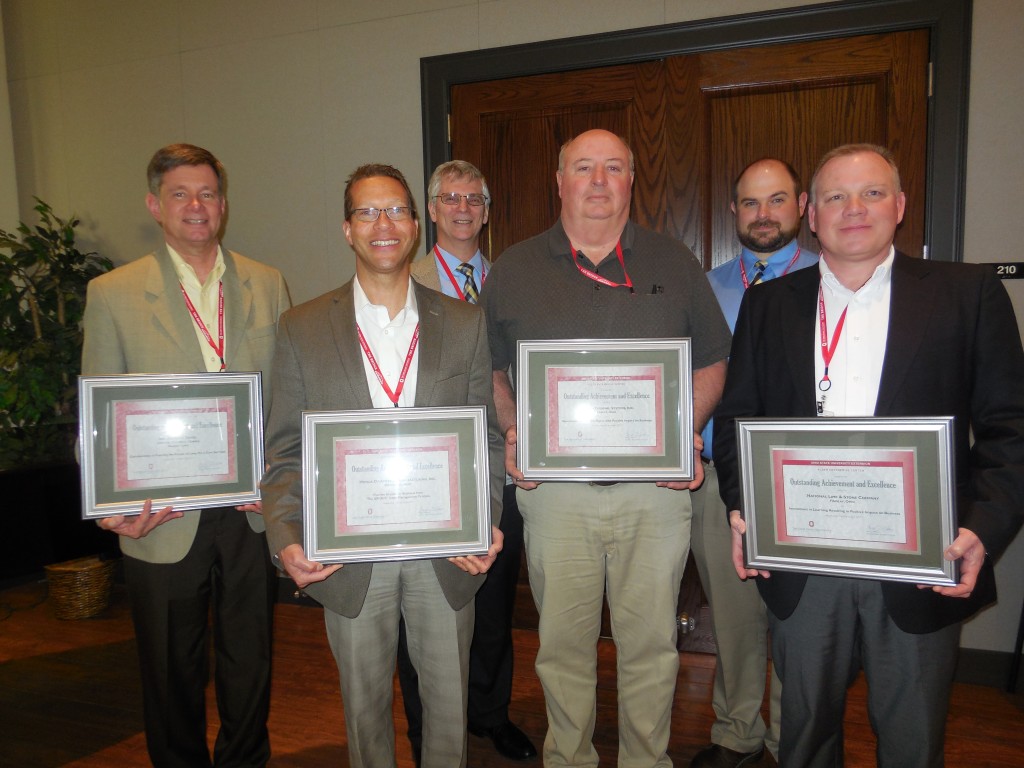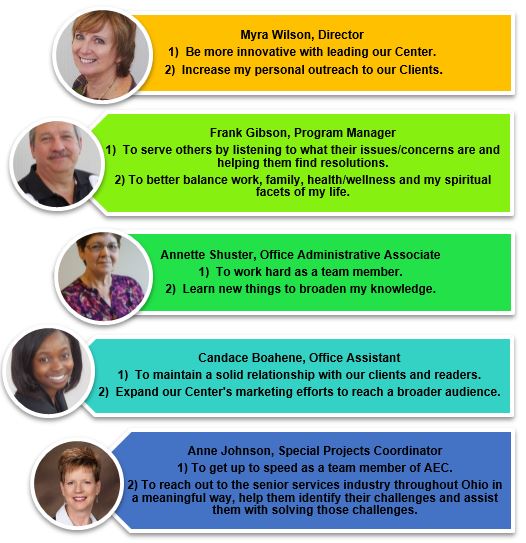
Ohio businesses who were recognized for outstanding achievement and excellence are (front row from left): Rev. Kenneth Daniel (President & CEO, United Church Homes), Scot McLemore (Technical Development Manager, Honda of America Manufacturing), Dave Rasor (Operations and Lean Champion, Triumph Thermal Systems), Mike Patrick (Manager of Maintenance, National Lime & Stone Company), Mike Giangiordano (President, Triumph Thermal Systems) and Dan Sensel (Director of Engineering, Triumph Thermal Systems)
Six Ohio organizations were recently recognized for outstanding milestones in business by The Ohio State University’s Alber Enterprise Center.
Those receiving awards included: Ohio Presbyterian Retirement Services, United Church Homes, GrafTech International, LTD, Triumph Thermal Systems, Inc., National Lime & Stone Company, and Honda of America Manufacturing, Inc.
“We are honored to recognize the outstanding achievements each of these organizations has made in visioning the future of their particular industries,” explains Myra Wilson, Program Director, Alber Enterprise Center. “They are on the leading edge of leadership development, continuous improvement and innovative culture — three initiatives that form the focus of our mission.”
Each organization has collaborated with the Alber Enterprise Center to address organizational challenges and/or receive executive training tailored to their company needs.
Ohio Presbyterian Retirement Services, Columbus, received the Outstanding Achievement and Excellence Award for Collaboration in Framing the Future of Long-Term Care Services. Ohio Presbyterian Retirement Services and their various staff members have actively attended meetings and their vast amount of expertise have molded and encouraged the work of the Long Term Support Services & Health Care Consortium (LTSS & HCC). Their input is advantageous in aiding the group to shape the vision and future of long-term care services.
President and CEO for United Church Homes, Marion, Rev. Kenneth Daniel accepted the Outstanding Achievement and Excellence Award for Collaboration in Framing the Future of Long-Term Care Services. Rev. Daniel’s guidance and direction led the Center to embark on the beginning stages of the long term support services path. His insights and industry knowledge was instrumental in developing a survey and gathering information that helped shape and guide the work of the Long Term Support Services & Health Care Consortium (LTSS & HCC). These continued efforts are helping AEC and the consortium take an in depth look at healthcare issues and develop solutions that will be impactful for years to come.
GrafTech International, LTD, Lakewood, received the Outstanding Achievement and Excellence Award for Continual Commitment to Human Capital Investment. Over a 3-year period, GrafTech have trained personnel through Structured On-the-Job Training (SOJT) and developed employee portfolios that capture work experience, education, certifications and training. As of June 30, 2014, AEC has issued 223 certificates to GrafTech employees for either Task and or Job Mastery. They also are projecting 120 more Job/Task Mastery certificates that will be issued by June 30, 2015.

(from left) Frank Gibson, Program Manager, and Myra Wilson, Program Director of Alber Enterprise Center presented one of the outstanding client awards to Hardin County’s Triumph Thermal Systems. Accepting the certificate were Mike Giangiordano, President; Dave Rasor, Operations and Lean Champion; and Dan Sensel, Director of Engineering. John Hohn, Director of Economic Development for Hardin County Chamber Business Alliance, congratulated the Triumph team.
President of Triumph Thermal Systems, Inc., Forest, Mike Giangiordano accepted the Outstanding Achievement and Excellence Award for Investment in Lean Six Sigma with Positive Impact on Business. Triumph Thermal Systems took an innovative approach to improving quality, efficiency and effectiveness by implementing Lean Six Sigma (LLS) follow up training to continue the initial training previously provided to their yellow belts, green belts and black belts. This past year they invested in training twelve employees in various levels of Lean Six Sigma process improvement. This training continued to enable teams to identify and implement the process, especially to increase higher product quality in two key production areas.
Manager of Maintenance for National Lime & Stone Company, Findlay, Mike Patrick accepted Outstanding Achievement and Excellence Award for Investment in Learning Resulting in Positive Impact on Business. For over ten years, National trained personnel through classroom, hands-on or eLearning. They covered a plethora of topics including customer service, hydraulics, welding, Microsoft office software, issue analysis, customer service and electrical safety. With approximately 40 locations throughout Ohio, National has experienced significant business growth over the years.
Technical Development Manager for Honda of America Manufacturing, Inc. Marysville, Scot McLemore accepted the Outstanding Achievement and Excellence Award for Positive Impact on Business from The BRIDGE: Issue Management Process. Honda’s successful utilization of AEC’s The BRIDGE: Issue Management Process laid the foundation in crafting a plan for feeding qualified workers into the employment pipeline for HAM (Honda of America Manufacturing, Inc.) and HNA (Honda North America) and helped stimulate positive change for maintainable economic growth.
 The concluding event for AEC’s Client Advisory Council half-day meeting was the Awards Luncheon. The meeting objective for clients was to provide feedback on AEC’s past services, input on how the Center can support the business priorities of other companies, offer suggestions about new services AEC could provide and ideas for strategic direction.
The concluding event for AEC’s Client Advisory Council half-day meeting was the Awards Luncheon. The meeting objective for clients was to provide feedback on AEC’s past services, input on how the Center can support the business priorities of other companies, offer suggestions about new services AEC could provide and ideas for strategic direction.
The Alber Enterprise Center applies the resources of The Ohio State University, OSU Extension, along with a team of organization development consultants to enable Ohio businesses to positively impact economic growth. For more information, call 740-725-6325 or visit alber.osu.edu.

 You know that with better leadership skills, your team could start performing at a whole new level. Here are five ways to boost your team’s leadership skills today.
You know that with better leadership skills, your team could start performing at a whole new level. Here are five ways to boost your team’s leadership skills today.












